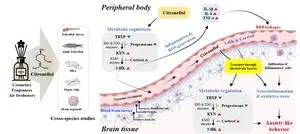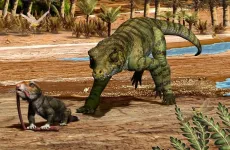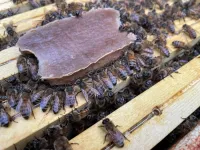(Press-News.org) By Dr Kelly Dunning
The Endangered Species Act (ESA), now 50 years old, was once a rare beacon of bipartisan unity, signed into law by President Richard Nixon with near-unanimous political support. Its purpose was clear: protect imperiled species and enable their recovery using the best available science to do so. Yet, as our case study on the grizzly bear in the Greater Yellowstone Ecosystem reveals, wildlife management under the ESA has changed, becoming a political battleground where science is increasingly drowned out by partisan ideology, bureaucratic delays, power struggles, and competing political interests. The survival of the ESA, a wildlife policy mimicked all over the world, may depend on our ability to navigate these waters.
The grizzly bear, a cultural symbol of the American West, embodies this shift. Listed as threatened in 1975 when its numbers dwindled to fewer than 1,000 and its range contracted by 98%, the species has managed to come back from the brink. In the Greater Yellowstone Ecosystem, the population now exceeds 700, a number that surpassed recovery goals set by the federal wildlife management agency tasked with recovery, the US Fish & Wildlife Service. By the ESA’s own metrics, this is a success story, which now means the grizzly bear is eligible for ‘delisting’. Yet, attempts to remove federal protections in 2007 and 2017 were overturned by courts, not because the science was lacking, but because the process has become a lightning rod for political interests.
Our study looks at 750 documents and 2,832 stakeholder quotes to track this politicization. Historically, wildlife management is the strict domain of agency scientists in the executive branch. These scientists are experts trained to interpret interdisciplinary scientific data and balance both human and ecological needs.
Our work shows that today, the most dominant voices belong to legislators, legal advocates, and non-governmental organizations (NGOs) who are increasingly crowding out the agency scientists. Senators, elected politicians, like Wyoming’s John Barrasso proclaim, “The grizzly is fully recovered in Wyoming. End of story,” pushing for state control and criticizing the ESA as sluggish and outdated. Can you blame him though? Senator Barraso advocates for his Wyoming constituents who have collaborated in grizzly recovery and are now on the frontlines of human-wildlife conflict issues where grizzlies might harm livestock or tourists. All the while, population targets set by the ESA have been met, and the species remains listed.
Meanwhile, NGOs and their attorneys, such as the well-known environmental advocacy group Earthjustice, argue that delisting is premature, citing ‘political pressure’ overriding ‘biological evidence.’ The courts, too, have flexed their muscle, with rulings hinging on genetic connectivity’s role in population recovery. Ranchers with increasing grizzly conflict see these scientific developments as intentional delays to delisting rather than advancements in the field of conservation. There are no easy answers.
Wildlife management turned politics
This conflict reveals a stark reality: wildlife management is no longer just about science, it's about who dominates the political discourse, and the power that accompanies it. Legislators see delisting as a way to reclaim state authority from what they consider federal overreach. Their rhetoric, steeped in populist appeals to the Western ranching community, frames grizzlies as a recovered species with bureaucrats in Washington stalling the process of handing management back over to the states.
Montana Senator Steve Daines, for instance, highlights ‘skyrocketing’ livestock losses and bears roaming beyond their historic range. These issues resonate with rural constituents tired of federal wildlife law superseding local management by trusted state agencies. On the other hand, NGOs and legal advocates rely on the courts to maintain federal oversight, warning that state management could unleash ‘trigger-happy’ hunting seasons and jeopardize long-term survival. These advocates argue that we are facing a generational extinction crisis, where every decision we make about imperiled species could approach extinction, a route that we cannot come back from. The public, caught in the middle, may be unaware that conversations over wildlife protection have shifted from credentialed agency biologists and scientists over to politicians.
Our data underscore this shift in power. While executive branch officials, with whom scientific expertise resides, once dominated the discourse (eg fish and wildlife agency personnel at the federal and state level), they are no longer the leading voices in ESA recovery conversations. Elected politicians now lead the charge. Their influence is growing threefold over time compared to scientific agency voices. Legal advocates and NGOs, meanwhile, are shaping the debate over wildlife science with their roles amplified by lawsuits that keep grizzlies listed. Even tribes, historically sidelined, find their strongest platform in court, a sign that political systems still fail to integrate Indigenous perspectives outside litigation.
What’s lost in this debate is the ESA’s original intent: a science-driven process to recover species and then allow federal agency experts to step back so that states, who may better represent local interests, can manage species.
The path forward
This politicization threatens the ESA’s future. When politicians outshout scientists, when courts dictate biology or delay timely management responses, and when recovery becomes a bargaining chip, the law risks losing its credibility with the public. The grizzly saga suggests a path forward: agencies must adapt to this political reality, not retreat from it. Scientists can’t afford to ‘stay out of politics’ when protected species like grizzlies are lightning rods for political debate. Multi-stakeholder groups, like the Interagency Grizzly Bear Committee, offer a model bridging agencies, states, tribes, and NGOs to tackle thorny issues like genetics collaboratively rather than through unending lawsuits in the courts.
The grizzly bear’s fate isn’t just about one species: this pattern is playing out across a range of species in the West and beyond. It will prove itself as the greatest challenge for wildlife managers in an era of increased polarization. If the ESA is to endure another 50 years, it must evolve beyond a scientific ideal into a framework that navigates the messy, human politics of conservation. Otherwise, the grizzly’s roar will be drowned out by an even greater sound: the chaos of our own imperfect politics.
END
The bear in the (court)room: who decides on removing grizzly bears from the endangered species list?
Guest editorial by Dr Kelly Dunning, Timberline Professor of Sustainable Tourism and Outdoor Recreation at the University of Wyoming
2025-04-16
ELSE PRESS RELEASES FROM THIS DATE:
First study reveals neurotoxic potential of rose-scented citronellol at high exposure levels
2025-04-16
Citronellol, a rose-scented compound commonly found in cosmetics and household products, has long been considered safe. However, a Korean research team has, for the first time, identified its potential to cause neurotoxicity when excessively exposed.
A collaborative research team led by Dr. Myung Ae Bae at the Korea Research Institute of Chemical Technology (KRICT) and Professors Hae-Chul Park and Suhyun Kim at Korea University has discovered that high concentrations of citronellol can trigger neurological and behavioral toxicity. The study, published in the Journal ...
For a while, crocodile
2025-04-16
Most people think of crocodylians as living fossils— stubbornly unchanged, prehistoric relics that have ruled the world’s swampiest corners for millions of years. But their evolutionary history tells a different story, according to new research led by the University of Central Oklahoma (UCO) and the University of Utah.
Crocodylians are surviving members of a 230-million-year lineage called crocodylomorphs, a group that includes living crocodylians (i.e. crocodiles, alligators and gharials) and their many extinct ...
Scientists find evidence that overturns theories of the origin of water on Earth
2025-04-16
Images available via link in the notes section
University of Oxford researchers have helped overturn the popular theory that water on Earth originated from asteroids bombarding its surface;
Scientists have analysed a meteorite analogous to the early Earth to understand the origin of hydrogen on our planet.
The research team demonstrated that the material which built our planet was far richer in hydrogen than previously thought.
The findings, which support the theory that the formation of habitable conditions on Earth did not rely on asteroids ...
Foraging on the wing: How can ecologically similar birds live together?
2025-04-16
UNIVERSITY PARK, Pa. — A spat between birds at your backyard birdfeeder highlights the sometimes fierce competition for resources that animals face in the natural world, but some ecologically similar species appear to coexist peacefully. A classic study in songbirds by Robert MacArthur, one of the founders of modern ecology, suggested that similar wood warblers — insect-eating, colorful forest songbirds — can live in the same trees because they actually occupy slightly different locations in the tree and presumably eat different insects. Now, a new study is using modern techniques to revisit MacArthur’s ...
Little birds’ personalities shine through their song – and may help find a mate
2025-04-16
In birds, singing behaviours play a critical role in mating and territory defence.
Although birdsong can signal individual quality and personality, very few studies have explored the relationship between individual personality and song complexity, and none has investigated this in females, say Flinders University animal behaviour experts.
They have examined the relationships between song complexity and two personality traits (exploration and aggressiveness) in wild superb fairy-wrens (Malurus cyaneus) in Australia, a species in which both sexes learn to produce complex songs.
“Regardless of their sex ...
Primate mothers display different bereavement response to humans
2025-04-16
Macaque mothers experience a short period of physical restlessness after the death of an infant, but do not show typical human signs of grief, such as lethargy and appetite loss, finds a new study by UCL anthropologists.
Published in Biology Letters, the researchers found that bereaved macaque mothers spent less time resting (sleep, restful posture, relaxing) than the non-bereaved females in the first two weeks after their infants’ deaths.
Researchers believe this physical restlessness could represent an initial period of ‘protest’ among the bereaved macaque mothers, similar ...
New pollen-replacing food for honey bees brings new hope for survival
2025-04-16
PULLMAN, Wash., -- Scientists have unveiled a new food source designed to sustain honey bee colonies indefinitely without natural pollen.
Published April 16 in the journal Proceedings of the Royal Society B, the research from Washington State University and APIX Biosciences NV in Wingene, Belgium details successful trials where nutritionally stressed colonies, deployed for commercial crop pollination in Washington state, thrived on the new food source.
This innovation, which resembles the man-made diets ...
Gene-based blood test for melanoma may catch early signs of cancer’s return
2025-04-15
Monitoring blood levels of DNA fragments shed by dying tumor cells may accurately predict skin cancer recurrence, a new study shows.
Led by researchers at NYU Langone Health and its Perlmutter Cancer Center, the study showed that approximately 80% of stage III melanoma patients who had detectable levels of circulating tumor DNA (ctDNA) before they started treatment to suppress their tumors went on to experience recurrence.
The researchers also found that the disease returned more than four times faster in this group than in those with no detectable levels of the biomarker, and the higher ...
Common genetic variants linked to drug-resistant epilepsy
2025-04-15
Certain common genetic changes might make some people with focal epilepsy less responsive to seizure medications, finds a new global study led by researchers at UCL and UTHealth Houston.
Focal epilepsy is a condition where seizures start in one part of the brain. It is the most common type of epilepsy.
Antiseizure medication is usually prescribed for people with the condition. However, for one in three people with epilepsy (around 20 million individuals worldwide), current antiseizure medications are ineffective. This means ...
Brisk walking pace + time spent at this speed may lower risk of heart rhythm abnormalities
2025-04-15
A brisk walking pace, and the amount of time spent at this speed, may lower the risk of heart rhythm abnormalities, such as atrial fibrillation, tachycardia (rapid heartbeat), and bradycardia (very slow heartbeat), finds research published online in the journal Heart.
The findings were independent of known cardiovascular risk factors, but strongest in women, the under 60s, those who weren’t obese, and those with pre-existing long term conditions.
Heart rhythm abnormalities (arrhythmias) are common, note the authors, with atrial fibrillation ...
LAST 30 PRESS RELEASES:
New study highlights link between eviction rates and gun violence
Heatwaves heat up soil but not toxin levels in rice, study finds
Digital modeling reveals where construction carbon emissions really come from
Turning farm waste into water filters
New study shows how the spleen helps the immune system accept a transplant
New Mayo Clinic study advances personalized prostate cancer education with an EHR-integrated AI agent
Researchers identify novel therapeutic target to improve recovery after nerve injury
Microbes in breast milk help populate infant gut microbiomes
Reprogramming immunity to rewrite the story of Type 1 diabetes
New tool narrows the search for ideal material structures
Artificial saliva containing sugarcane protein helps protect the teeth of patients with head and neck cancer
Understanding the role of linear ubiquitination in T-tubule biogenesis
Researchers identify urban atmosphere as primary reservoir of microplastics
World’s oldest arrow poison – 60,000-year-old traces reveal early advanced hunting techniques
Bristol scientists discover early sponges were soft
New study uncovers how rice viruses manipulate plant defenses to protect insect vectors
NSF–DOE Vera C. Rubin Observatory spots record-breaking asteroid in pre-survey observations
Ribosomal engineering creates “super-probiotic” bacteria
This self-powered eye tracker harnesses energy from blinking and is as comfortable as everyday glasses
Adverse prenatal exposures linked to higher rates of mental health issues, brain changes in adolescents
Restoring mitochondria shows promise for treating chronic nerve pain
Nature study identifies a molecular switch that controls transitions between single-celled and multicellular forms
USU chemists' CRISPR discovery could lead to single diagnostic test for COVID, flu, RSV
Early hominins from Morocco reveal an African lineage near the root of Homo sapiens
Small chimps, big risks: What chimps show us about our own behavior
We finally know how the most common types of planets are created
Thirty-year risk of cardiovascular disease among healthy women according to clinical thresholds of lipoprotein(a)
Yoga for opioid withdrawal and autonomic regulation
Gene therapy ‘switch’ may offer non-addictive pain relief
Study shows your genes determine how fast your DNA mutates with age
[Press-News.org] The bear in the (court)room: who decides on removing grizzly bears from the endangered species list?Guest editorial by Dr Kelly Dunning, Timberline Professor of Sustainable Tourism and Outdoor Recreation at the University of Wyoming








